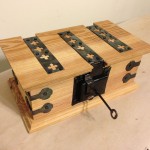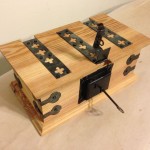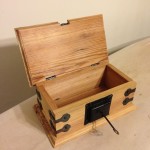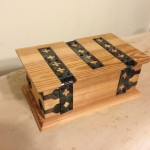With the lock installed and functioning, the next step was to actually build the box.
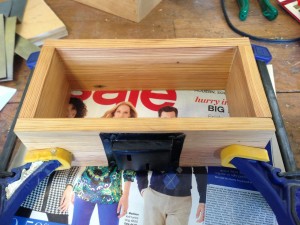 The sides of the box were put together with wood glue and clamps. I thought about putting some extra nails in the corners that would be hidden by the straps, but it seemed like overkill. Also, I didn’t want to risk splitting the edges of any of the boards.
The sides of the box were put together with wood glue and clamps. I thought about putting some extra nails in the corners that would be hidden by the straps, but it seemed like overkill. Also, I didn’t want to risk splitting the edges of any of the boards.
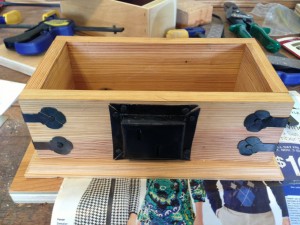 Here’s a shot of the front with the corner straps and bottom attached. Due to the aforementioned splitting worries (I don’t have any of this wood left to replace broken boards), I drilled pilot holes for each nail about halfway through the thickness of the wood. I also did most of the nailing with the boards supported by the horn of the anvil, or on the face when I could. All the hardware was blackened using the same method as the lock cover, but with only one coat of oil.
Here’s a shot of the front with the corner straps and bottom attached. Due to the aforementioned splitting worries (I don’t have any of this wood left to replace broken boards), I drilled pilot holes for each nail about halfway through the thickness of the wood. I also did most of the nailing with the boards supported by the horn of the anvil, or on the face when I could. All the hardware was blackened using the same method as the lock cover, but with only one coat of oil.
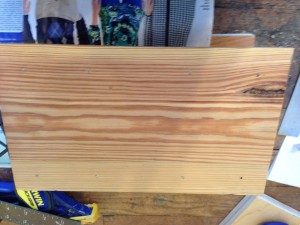 The bottom was attached with glue and thoroughly modern looking finishing nails. I wanted to make sure I could put this box down on a table without worrying about it scratching anything, so this seemed like the best option. The bottom board had the most cracks in it (and in fact broke in half at one point and needed to be glued back together), so I put it in the position where it would be the most supported.
The bottom was attached with glue and thoroughly modern looking finishing nails. I wanted to make sure I could put this box down on a table without worrying about it scratching anything, so this seemed like the best option. The bottom board had the most cracks in it (and in fact broke in half at one point and needed to be glued back together), so I put it in the position where it would be the most supported.
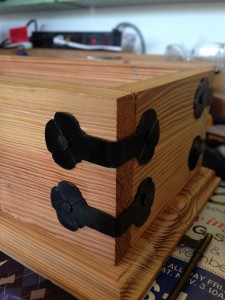 A close up of the corner straps. I marked the front and back boards to make sure the straps were at the right height, but each had to be positioned individually since they were nowhere near identical.
A close up of the corner straps. I marked the front and back boards to make sure the straps were at the right height, but each had to be positioned individually since they were nowhere near identical.
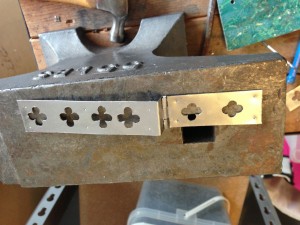 One of the hinges. The quatrefoils aren’t quite evenly spaced, but they are consistent between the three straps. I experimented with a scalloped edge at the end of the straps, but it didn’t seem to be worth the effort, and might not have looked very balanced.
One of the hinges. The quatrefoils aren’t quite evenly spaced, but they are consistent between the three straps. I experimented with a scalloped edge at the end of the straps, but it didn’t seem to be worth the effort, and might not have looked very balanced.
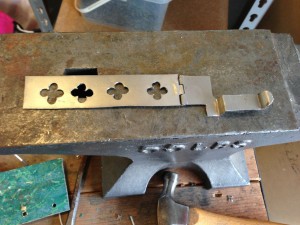 After getting the lock in place, it turned out that my original hasp wasn’t going to line up with the slot like it needed to. Fortunately, hasps with this sort of dog-leg are quite common. I cut a new one and kept on truckin’.
After getting the lock in place, it turned out that my original hasp wasn’t going to line up with the slot like it needed to. Fortunately, hasps with this sort of dog-leg are quite common. I cut a new one and kept on truckin’.
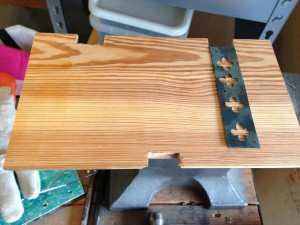 Laying out the first hinge strap. Here you can see the notches I had to cut in the box lid to accommodate the hardware. Not an ideal solution, but the best I could do.
Laying out the first hinge strap. Here you can see the notches I had to cut in the box lid to accommodate the hardware. Not an ideal solution, but the best I could do.
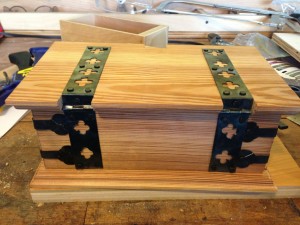 Here are the hinges fully installed. This is one of my favorite pictures. The position of the hinges meant the straps on the back overlapped the ends of the corner straps. This is pretty common in period examples, and I’m glad I didn’t try to avoid it (to be perfectly honest, it didn’t even occur to me that this might happen until it did).
Here are the hinges fully installed. This is one of my favorite pictures. The position of the hinges meant the straps on the back overlapped the ends of the corner straps. This is pretty common in period examples, and I’m glad I didn’t try to avoid it (to be perfectly honest, it didn’t even occur to me that this might happen until it did).
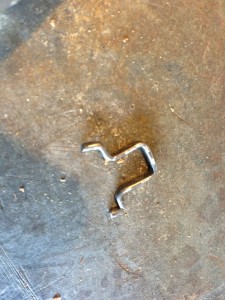 This was the first version of the staple for the hasp. The final one was just about the same shape, but made form a thin strip of sheet instead of a flattened coat hanger. The coat hanger ended up being too hard and brittle to make all the sharp bends I needed.
This was the first version of the staple for the hasp. The final one was just about the same shape, but made form a thin strip of sheet instead of a flattened coat hanger. The coat hanger ended up being too hard and brittle to make all the sharp bends I needed.
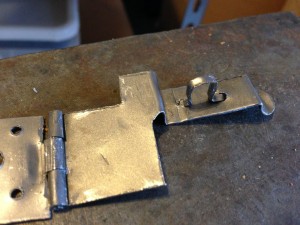 Here is the final version of the hasp. I had to tinker with the shape and position of the staple quite a bit to get it to engage the bolt properly, but it seems to have ended up working fine. The ends are simply bent back toward the center on the other side and crimped down.
Here is the final version of the hasp. I had to tinker with the shape and position of the staple quite a bit to get it to engage the bolt properly, but it seems to have ended up working fine. The ends are simply bent back toward the center on the other side and crimped down.
All that’s left to do is fabricate and install the handle and give it a linseed oil finish. Here are some pics of the (nearly) complete casket:

